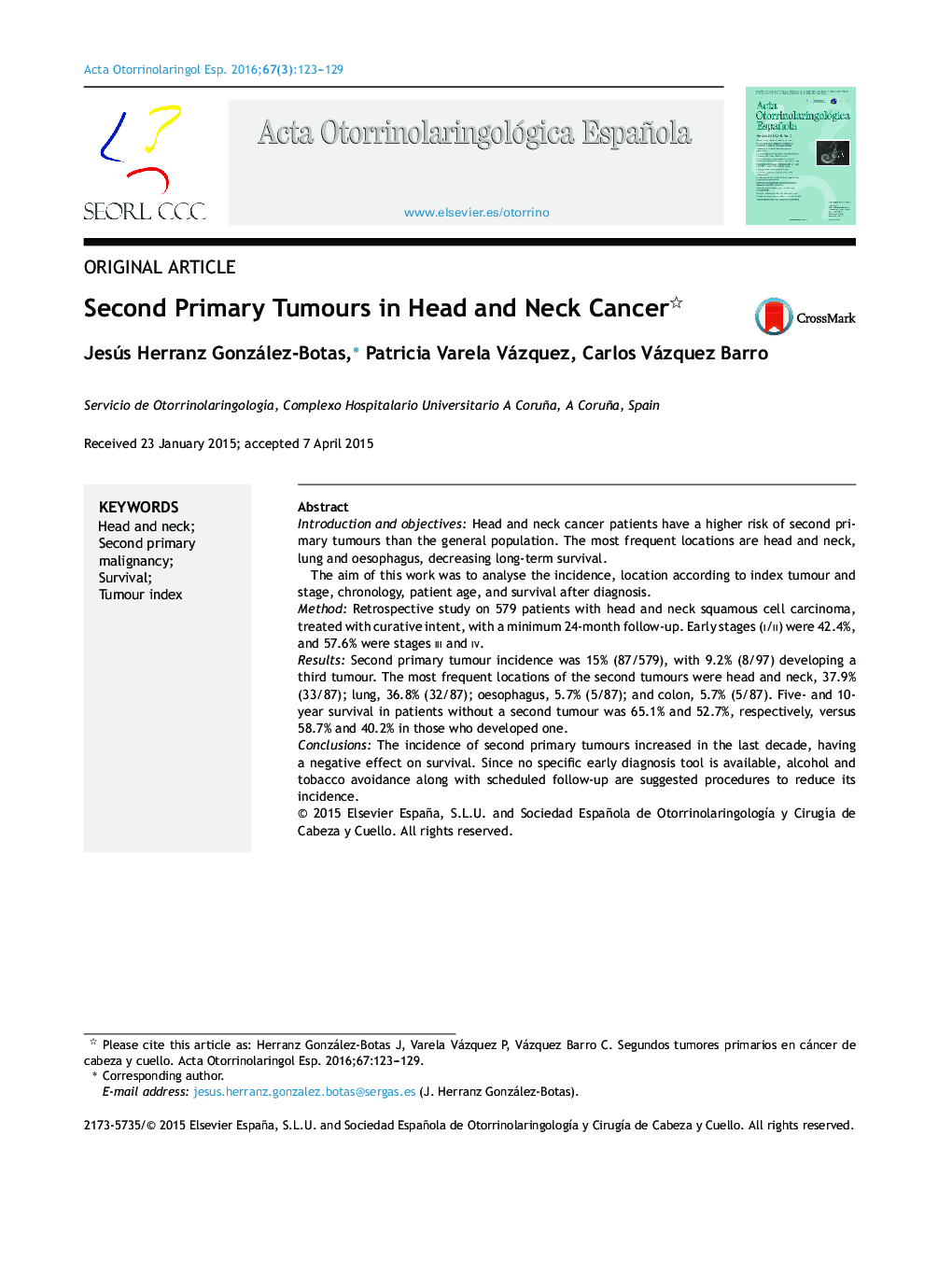| Article ID | Journal | Published Year | Pages | File Type |
|---|---|---|---|---|
| 4100614 | Acta Otorrinolaringologica (English Edition) | 2016 | 7 Pages |
Introduction and objectivesHead and neck cancer patients have a higher risk of second primary tumours than the general population. The most frequent locations are head and neck, lung and oesophagus, decreasing long-term survival.The aim of this work was to analyse the incidence, location according to index tumour and stage, chronology, patient age, and survival after diagnosis.MethodRetrospective study on 579 patients with head and neck squamous cell carcinoma, treated with curative intent, with a minimum 24-month follow-up. Early stages (I/II) were 42.4%, and 57.6% were stages III and IV.ResultsSecond primary tumour incidence was 15% (87/579), with 9.2% (8/97) developing a third tumour. The most frequent locations of the second tumours were head and neck, 37.9% (33/87); lung, 36.8% (32/87); oesophagus, 5.7% (5/87); and colon, 5.7% (5/87). Five- and 10-year survival in patients without a second tumour was 65.1% and 52.7%, respectively, versus 58.7% and 40.2% in those who developed one.ConclusionsThe incidence of second primary tumours increased in the last decade, having a negative effect on survival. Since no specific early diagnosis tool is available, alcohol and tobacco avoidance along with scheduled follow-up are suggested procedures to reduce its incidence.
ResumenIntroducción y objetivosLos segundos tumores primarios afectan más a pacientes con cáncer de cabeza y cuello que a la población general. Con preferencia por cabeza y cuello, pulmón y esófago, afectan la supervivencia a largo plazo.El objetivo es estudiar la incidencia, localización en relación con el tumor índice y su estadio, cronología de aparición, relación con la edad del paciente y supervivencia posdiagnóstico.Material y métodoEstudio retrospectivo de 579 pacientes diagnosticados de carcinoma epidermoide de cabeza y cuello, tratados con intención curativa y seguimiento mínimo de 24 meses. El 42,4% (246/579) eran estadios I y II, y el 57,6% (334/579) restante eran estadios III y IV.ResultadosEl 15% (87/579) de los pacientes desarrollaron un segundo tumor, y el 9,2% (8/97) desarrollaron un tercer tumor. Las localizaciones más frecuentes fueron cabeza y cuello, 37,9% (33/87), pulmón, 36,8% (32/87), esófago, 5,7% (5/87) y colorrectal, 5,7% (5/87). La supervivencia a 5 y 10 años de pacientes sin segundo tumor fue del 65,1 y 52,7% respectivamente, frente a una 58,7 y 40,2% de los que sí lo desarrollaron.ConclusionesLa incidencia de segundos tumores se ha incrementado en los últimos años y suponen una disminución en la supervivencia de los pacientes. La revisión periódica y la reducción del consumo de alcohol y tabaco son, ante la ausencia de diagnóstico precoz efectivo, la mejor manera de reducir su incidencia.
